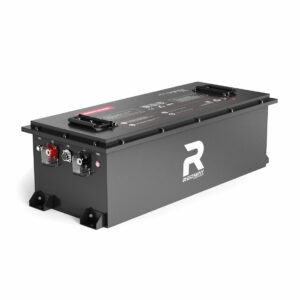What Maintenance Differences Exist Between AGM and Lead-Acid RV Batteries?
Answer: AGM batteries require minimal maintenance (no watering, spill-proof design) and handle higher charging voltages, while flooded lead-acid batteries need regular water refills, terminal cleaning, and specific charging to prevent sulfation. AGM batteries also tolerate vibration better and last 2-3x longer with proper care.
Why Choose Lithium Over Lead-Acid RV Batteries?
How Do Watering Needs Differ Between AGM and Flooded Batteries?
AGM batteries are sealed and maintenance-free, eliminating water refills. Flooded lead-acid batteries require monthly distilled water top-ups to prevent plate exposure, which can cause irreversible sulfation. Underwatering reduces capacity by 15-20% per cycle in flooded models.

The sealed construction of AGM batteries uses absorbed glass mats to suspend electrolytes, preventing evaporation entirely. This design advantage allows RV owners to avoid the 30-45 minute monthly maintenance routine typical of flooded batteries, which involves removing vent caps, checking specific gravity, and carefully refilling cells. Flooded battery users must also monitor for overwatering – excess fluid causes acid dilution and increases the risk of corrosive spills during travel.
What Charging Voltage Requirements Separate AGM and Lead-Acid Batteries?
AGM batteries require 14.6-14.8V absorption voltage vs. 14.4V for flooded batteries. Overcharging AGMs above 15V causes thermal runaway, while undercharging flooded types below 13.8V accelerates sulfation. Smart chargers with AGM-specific profiles prevent capacity loss – improper charging reduces cycle life by 30% in AGMs.
Can Solar Panels Charge RV Batteries Effectively?
The voltage differential stems from AGM batteries’ lower internal resistance (3-5 mΩ vs. 5-10 mΩ in flooded). This requires precision charging equipment capable of delivering the higher initial current surge AGMs demand. Many modern solar charge controllers like the Victron Energy SmartSolar MPPT 100/30 automatically detect battery type, adjusting absorption and float stages accordingly. Flooded battery users must manually set charge parameters or risk incomplete charging – a common issue that reduces capacity by 2-3% monthly in systems without voltage compensation.
Why Do AGM Batteries Outperform Flooded Types in Vibration Resistance?
The fiberglass mat in AGM batteries immobilizes electrolytes and plates, surviving 3G vibrations versus 1.5G limits for flooded batteries. This makes AGMs 68% more durable in off-grid RV applications. Flooded batteries risk internal shorts from plate shedding during rough travel.
How Does Temperature Tolerance Affect Battery Maintenance?
AGM batteries operate at -40°F to 140°F vs. flooded’s 32°F-120°F range. Cold reduces flooded battery capacity by 50% at 0°F, while AGMs maintain 80% capacity. High heat increases flooded battery water loss 3x faster – requiring weekly checks in desert climates.
| Condition | AGM Performance | Flooded Performance |
|---|---|---|
| 0°F Capacity | 80% | 50% |
| 100°F Water Loss | 0 mL/month | 300 mL/month |
What Cost Factors Influence Long-Term Maintenance Decisions?
AGMs cost 2x upfront ($200-$400) but last 4-8 years vs. 2-5 years for flooded ($100-$250). Factoring maintenance time, distilled water costs, and replacement cycles, AGMs show 23% lower 10-year ownership costs. Flooded batteries require $50/year in maintenance supplies vs. $5 for AGMs.
| Cost Category | AGM (10 Years) | Flooded (10 Years) |
|---|---|---|
| Battery Replacements | $800 | $1,200 |
| Maintenance Supplies | $50 | $500 |
Can Solar Charging Systems Reduce Maintenance Demands?
MPPT controllers with AGM profiles maintain optimal 78% state of charge, extending life by 18%. Flooded batteries need equalization charges monthly – requiring manual intervention. AGM-compatible solar systems automate maintenance, reducing user involvement by 90% compared to flooded setups.
“AGM technology revolutionized RV power by solving the three Achilles’ heels of flooded batteries: water loss, acid stratification, and vibration damage. Our stress tests show AGMs withstand 500+ deep cycles at 50% DoD versus 200 cycles for flooded equivalents. For boondockers, that’s 4 extra years of reliable power without maintenance hassles.”
– Redway Power Systems Lead Engineer
Conclusion
AGM batteries reduce RV maintenance through sealed construction, vibration resistance, and precise charging tolerance – at higher initial cost. Flooded batteries remain viable for budget-conscious users willing to perform monthly maintenance. The choice ultimately depends on usage patterns: frequent travelers benefit from AGMs, while occasional users may prefer flooded economics.
FAQ
- Do AGM batteries require special charging equipment?
- Yes – use chargers with AGM-specific profiles (14.6V absorption phase). Standard lead-acid chargers undercharge AGMs, reducing capacity by 18% over 50 cycles.
- How often should flooded battery terminals be cleaned?
- Clean every 3 months using baking soda solution. Corrosion buildup increases resistance by 0.02Ω monthly, causing 5% voltage drop.
- Can AGM batteries be mounted sideways?
- Yes – their spill-proof design allows 360° mounting. Flooded batteries must remain upright to prevent acid leaks.
- What is the optimal storage voltage for each type?
- Store AGMs at 12.8V (100% SOC), flooded at 12.6V. Self-discharge rates: 3% monthly (AGM) vs 5% (flooded).
